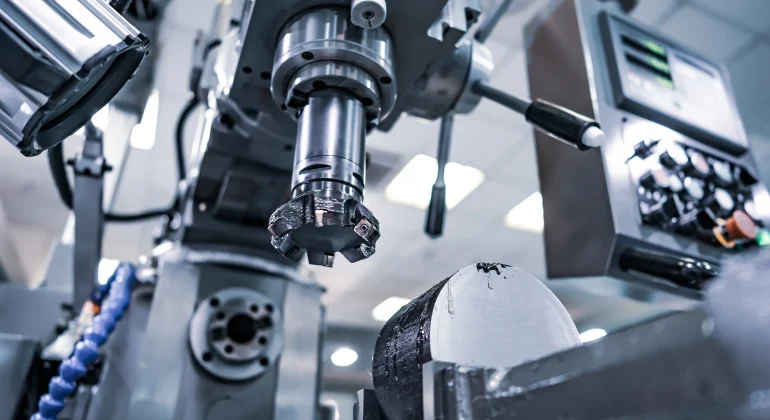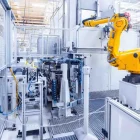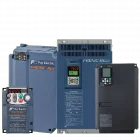Low Voltage Variable Speed Drives for Efficiency and Savings
Imagine you are behind the wheel of a car. You don’t always need to floor the gas pedal, right? Sometimes, you need to slow down for a sharp turn, speed up to merge into traffic, or even come to a complete stop. Low voltage variable speed drives (VSDs) work similarly for electric motors. Instead of running constantly at a constant speed, they adjust the motor’s speed based on what is needed at that moment. This could mean slowing down a conveyor belt when there is less product to move, speeding up a pump to boost flow, or smoothly starting and stopping a fan.
Why Does This Matter?
Energy Savings
VSDs can significantly reduce energy use by running motors only as fast as necessary. This not only means lower electricity bills but also a more minor environmental impact.
Improved Performance
VSDs allow precise control over motor speed and torque, resulting in smoother operations, increased productivity, and better-quality products.
Reduced Wear and Tear
With fewer sudden starts and stops, VSDs help extend the lifespan of motors and other equipment.
Enhanced Safety
VSDs can prevent equipment overloads and improve safety by providing gentle starts and stops.
In simple terms, low-voltage VSDs act like smart controllers for electric motors. They optimize performance, save energy, and enhance operations’ overall efficiency.
Understanding Variable Frequency Drives (VFDs): Key Insights for Industrial Applications
In industrial automation, Variable Frequency Drives (VFDs) play a crucial role in optimizing motor performance, reducing energy consumption, and enhancing system control. These devices allow for precise motor speed regulation by adjusting the frequency and voltage supplied to the motor. As industries continually strive for more efficient and cost-effective solutions, understanding the functioning and advantages of VFDs and specific products like ABB drives becomes increasingly important.
What is a Variable Speed Drive?
A Variable Speed Drive (VSD) is a device used to control the speed of an electric motor by varying the frequency and voltage supplied to the motor. These drives are widely employed in various industries for their ability to provide energy-efficient solutions while also improving system performance. VSDs are versatile, offering applications in HVAC systems, pumps, fans, conveyor belts, and many other systems requiring motor control.
There are different types of variable speed drives, the most common being VFDs. VFDs not only control speed but also help maintain torque at variable speeds, making them suitable for both constant and variable load conditions. By adjusting the motor’s operating conditions to match the demand, VFDs minimize energy waste, leading to cost savings and a more sustainable operation.
Pro Tip: To maximize the lifespan and efficiency of your VSDs, establish a regular maintenance schedule. This includes checking for loose connections, monitoring temperature levels, and ensuring that cooling systems are functioning properly. Regular maintenance helps prevent unexpected failures and extends the life of both the drive and the motor.
What is the Lowest Speed for a VFD?
The lowest speed for a VFD depends on the specific motor and application, but typically, VFDs allow motors to run at speeds as low as 1% to 5% of their rated speed. This feature enables the motor to operate at extremely low speeds, which is particularly useful in applications requiring precise control over motion, such as pumping systems, conveyors, and mixers. However, it is important to note that running motors at extremely low speeds may reduce efficiency or lead to overheating if not properly managed.
For example, in a fan system, where airflow needs to be adjusted based on demand, a VFD can significantly lower the fan speed to conserve energy without sacrificing the required performance. Similarly, in processes such as material handling, adjusting the motor speed to match the load helps reduce energy consumption and wear and tear on machinery.
Considerations When Using VFDs
Variable Frequency Drives (VFDs) provide numerous benefits, but they also come with certain challenges. One key concern is harmonic distortion, which can affect power quality, interfere with other electrical equipment, and cause overheating in cables and transformers. In many cases, additional filters or harmonic mitigation devices are needed to address these issues, increasing system costs.
Another consideration is electromagnetic interference (EMI), which can arise from high-frequency switching in VFDs. If not properly managed, EMI may disrupt communication lines and sensitive electronic devices.
Fuji Electric’s VFDs are designed to mitigate these challenges efficiently, featuring a built-in EMC filter and DC reactor that minimize harmonic distortion without requiring extra components – helping to ensure stable and reliable operation.
Lastly, the initial cost of VFD installation is typically higher than conventional motor control methods, such as direct-on-line (DOL) starters. However, the long-term benefits – such as energy efficiency, extended equipment lifespan, and improved process control – often justify the investment.
VSDs: From Control to Intelligence
Modern Variable Speed Drives (VSDs) have come a long way from just controlling speed. Today, they are smart devices packed with advanced features that are changing the game for industrial machinery. With sophisticated sensors, powerful processors, and built-in connectivity, these “smart” VSDs are revolutionizing how we operate the equipment.
In this section, we will dive into the key features that make today’s VSDs so intelligent. We will look at how they enable predictive maintenance, seamlessly integrate with Industry 4.0 technologies, and utilize advanced control algorithms to enhance performance.
Predictive Maintenance
Data Collection
Modern VSDs are equipped with sensors and sophisticated software that continuously monitor key parameters like:
Motor current and voltage
Detecting anomalies that could indicate impending motor winding failures, bearing issues, or rotor imbalances.
Temperature
Monitoring motor and drive temperatures to prevent overheating and potential damage.
Vibration
Analyzing vibration patterns to identify mechanical problems like misalignment, bearing wear, or unbalance.
Torque
Monitoring torque output to detect load variations and potential process issues.
Data Analysis
Built-in algorithms or external software analyze this data to:
Identify trends and patterns
Spotting early signs of degradation or impending failures.
Predict potential problems
Providing early warnings of potential equipment failures, allowing for scheduled maintenance and minimizing downtime.
Optimize maintenance schedules
Determining the optimal time for maintenance based on real-time equipment condition, rather than fixed schedules.
Optimize maintenance schedules
Determining the optimal time for maintenance based on real-time equipment condition, rather than fixed schedules.
Integration with IoT and Industry 4.0
Data Connectivity
VSDs can be integrated with other devices and systems via:
Industrial communication protocols
Such as Ethernet, Modbus, Profibus, and others, enabling seamless data exchange.
Cloud platforms
Allowing for secure data storage, analysis, and visualization in the cloud.
Benefits of Integration
Remote monitoring and control
Operators can monitor and control VSDs and connected equipment remotely, improving operational efficiency and reducing response times to issues.
Predictive analytics and machine learning
Leveraging advanced analytics to optimize performance, predict maintenance needs, and improve overall equipment effectiveness (OEE).
Data-driven decision making
Utilizing real-time data to make informed decisions regarding production scheduling, energy management, and process optimization.
Advanced Control Algorithms:
Beyond Basic Speed Control
Modern VSDs go beyond simple speed control, offering advanced algorithms such as:
Vector control
Provides precise control over both speed and torque, improving dynamic performance and enabling more complex control strategies.
Direct torque control (DTC)
Offers fast response times and improved torque control, but may generate more harmonics.
Field-oriented control (FOC)
Provides high-performance control for high-speed applications and those requiring precise torque control.
Advanced Control Algorithms:
Improved performance
Enhanced speed and torque control lead to smoother operations, improved product quality, and increased productivity.
Energy efficiency
Optimized control algorithms can minimize energy consumption by adjusting motor operation to match the exact demands of the application.
Enhanced system stability
Improved control algorithms can enhance system stability and reduce the risk of oscillations or other instabilities.
These “smart” features elevate VSDs from basic motor speed controllers to intelligent devices capable of optimizing performance, boosting efficiency, and enhancing overall system reliability. By harnessing data, advanced analytics, and intelligent control algorithms, VSDs are becoming essential players in the digital transformation of industrial operations.
Pro Tip: Take advantage of the advanced control features offered by modern low-voltage variable speed drives. Many VSDs come equipped with options for real-time monitoring, adaptive control algorithms, and integration with automation systems. Leveraging these features can lead to improved operational efficiency and better energy management.
Low-Voltage Variable Speed Drives by Fuji Electric
Fuji Electric offers different kinds of low-voltage variable speed drives, namely the following:
Ace
Designed for general industrial applications, offering high performance and reliability with advanced features.
Eco
Focuses on energy efficiency and cost-effectiveness, ideal for applications prioritizing reduced energy consumption.
HVAC
Specifically tailored for heating, ventilation, and air conditioning systems, providing precise control and optimized performance for HVAC applications.
Mega
High-power drives for demanding applications requiring robust performance and high output capacity.
Mini
Compact and space-saving drives suitable for a wide range of applications where size and footprint are critical.
VG
A comprehensive series of general-purpose drives with various models to suit different needs:
Frenic - VG1
Entry-level drives offering a balance of performance and affordability.
Frenic - VG2
Mid-range drives with enhanced features and improved performance.
Frenic - VG3
High-performance drives with advanced functionalities and superior control capabilities.
FAQs
How can I maximize the lifespan and efficiency of my VSDs?
What are some key considerations when selecting a VSD for a specific application?
What are the key benefits of using low-voltage variable speed drives (VSDs)?
The benefits of using low-voltage variable speed drives (VSDs) are substantial. One of the primary advantages is energy savings; VSDs reduce energy consumption by adjusting motor speed to match actual demand, leading to lower electricity bills and a smaller environmental footprint. They also improve performance by enabling precise control over motor speed and torque, resulting in smoother operations, increased productivity, and enhanced product quality.
Furthermore, VSDs help reduce wear and tear on equipment by minimizing sudden starts and stops, which extends the lifespan of motors and other machinery. Additionally, they enhance safety by providing gentle starts and stops, thus reducing the risk of equipment overloads.
What is the difference between a Variable Speed Drive (VSD) and a Variable Frequency Drive (VFD)?
While the terms “VSD” and “VFD” are often used interchangeably, there’s a slight distinction. VSD is a broader term that encompasses any device used to control the speed of an electric motor. VFD is a specific type of VSD that controls motor speed by varying the frequency and voltage supplied to the motor. Most VSDs used today are VFDs.
How do VSDs improve energy efficiency in HVAC systems?
Several key considerations should be
considered when selecting a VSD for a specific application. First, ensure that
the VSD is compatible with the motor’s power rating and type, whether it’s an
AC induction motor or a synchronous motor. Next, consider the specific
requirements of the application such as speed range, torque needs, and
environmental conditions.
Energy efficiency is also crucial; choose a VSD with high efficiency ratings and energy-saving features to minimize operating costs. Additionally, evaluate your budget alongside potential energy savings and return on investment (ROI). Lastly, opt for a VSD from a reputable manufacturer known for good service and support options to ensure reliability in your operations.
About Fuji Electric Sales Philippines, Inc.
Fuji Electric Sales Philippines, Inc. brings innovative technology from Japan to businesses across the country. As a subsidiary of Fuji Electric Co., Ltd., the company promotes, sells, and supports products that improve energy efficiency, boost automation, and enhance electrical infrastructure.
Have questions about Fuji Electric VSD and how it can benefit your operations? Let our expert assist you. Call or message:
Rickson Manalo
Assistant Sales Manager
0917-115 6102








